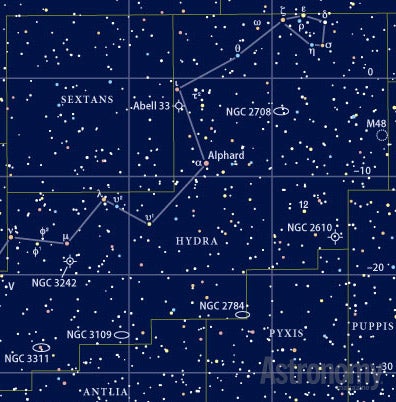Targets for February 26–March 5, 2015
Small-telescope: Open cluster NGC 2439
Small-telescope: Open cluster NGC 2506
8-inch or larger telescope: Planetary nebula NGC 2610
A pretty bright cluster
This week’s first small-telescope target is open cluster NGC 2439 in Puppis. It shines just out of range of naked eyes at magnitude 6.9 and measures 10′ across.
The easiest way to find it is to draw a line from magnitude 1.8 Wezen (Delta [δ] Canis Majoris) through magnitude 2.5 Aludra (Eta [η] Canis Majoris). Extend that line about an equal distance in the same direction, and you’ll land on NGC 2439.
Through a 4-inch telescope, you’ll see 15 stars forming a well-defined ring. R Puppis, a variable star that hovers around magnitude 6.6, lies at the northeastern edge. An additional 20 fainter stars surround the ring.
On the best nights with at least a 12-inch scope, look for the faint cluster Ruprecht 30. It appears as a light stellar dusting half as large as NGC 2439 lying 23′ to the brighter cluster’s northeast.
Diamonds on velvet
This week’s second small-scope object is open cluster NGC 2506 in Monoceros. Also known as Caldwell 54, this stellar group shines at magnitude 7.6 and measures 12′ across.
Look for it in the far southeastern corner of Monoceros, 0.5 from that constellation’s border with Puppis and less than 3 from its Hydra border. From magnitude 3.9 Alpha (α) Monocerotis, move 4.8 east-southeast, and you’ll land on NGC 2506.
Through a 4-inch telescope, this cluster’s stars all appear to be about the same brightness, but they have a wildly uneven distribution. Spread them out by using a magnification of 150x and you’ll see a clumpy center and lots of patterns: streamers, spiral “arms,” letters, and more.
Move up to a 12-inch scope at a magnification of 200x, and the scene gets interesting. The same 30 or 40 stars you saw through the smaller aperture now hang before a background glow that glistens like a diamond-encrusted black velvet sheet. The gaps between twisting lines of stars also appear wider and darker.
A nice planetary and more
This week’s large-telescope target is planetary nebula NGC 2610 in Hydra. You’ll find this magnitude 12.8 object in the Water Snake’s southwestern corner by sweeping 2° west of the magnitude 4.9 star 9 Hydrae.
Through anything less than a 16-inch telescope, this 37″-wide object appears circular and featureless, albeit with a pretty high surface brightness. Really big scopes show it as a thick ring with an elusive central star.
If you’re using a 16-inch or larger instrument, crank up the power and follow a line of two stars — the first, a nondescript magnitude 11.8 point and then magnitude 6.6 SAO 154395 — 6.5′ to the northeast.
When you center the latter star, you’re precisely halfway there. What you’re looking for is the ultra-faint galaxy PGC 902802, which glows unnoticed at magnitude 16.7. “PGC,” by the way, stands for the Catalogue of Principal Galaxies, first published in 1989.
Expand your observing at Astronomy.com
StarDome
Check out Astronomy.com’s interactive StarDome to see an accurate map of your sky. This tool will help you locate this week’s targets.
The Sky this Week
Get a daily digest of celestial events coming soon to a sky near you.
Observing Talk
After you listen to the podcast and try to find the objects, be sure to share your observing experience with us by leaving a comment at the blog or in the Reader Forums.











